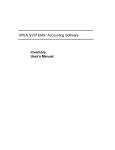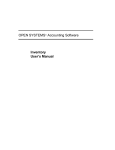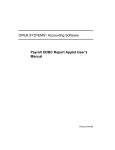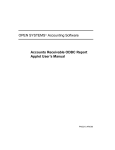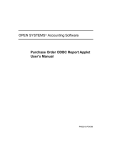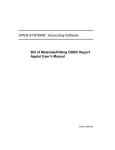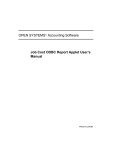Download OPEN SYSTEMS Accounting Software Inventory
Transcript
Inventory User’s Manual PN/2210.INO60 OPEN SYSTEMS Accounting Software Inventory ODBC Report Applet User’s Manual PN/2210.INO60 © 1998 Open Systems Holdings Corp. All rights reserved. Document Number 2210.INO600 No part of this manual may be reproduced by any means without the written permission of Open Systems Holdings Corp. OPEN SYSTEMS is a registered trademark and OSAS, Resource Manager, Resource Manager for Windows, and Report Writer are trademarks of Open Systems Holdings Corp. BBx is a trademark and PRO/5 and Visual PRO/5 are registered trademarks of BASIS International Ltd. Novell, NetWare, and UNIXWare are registered trademarks of Novell, Inc. Microsoft, Microsoft Access, Microsoft Windows, Microsoft Windows 95, Windows, MS-DOS and PivotTable are either trademarks or registered trademarks of Microsoft Corporation. Crystal Reports for Windows is a trademark of Seagate Software, Inc. TrueType is a registered trademark of Apple Computer, Inc. Printed in U.S.A. August 1998, Release 6.0 This document has been prepared to conform to the current release version of OPEN SYSTEMS Accounting Software. Because of our extensive development efforts and our desire to further improve and enhance the software, inconsistencies may exist between the software and the documentation in some instances. Call your customer support representative if you encounter an inconsistency. Inventory Report Applet User’s Manual Contents Contents Introduction General Information Inventory Data Files Introduction to PivotTables Creating Microsoft Excel PivotTables 1-3 1-5 1-9 1-11 Installation 2-1 IN PivotTables IN Bin Analysis IN COGS Adjustments IN History Detail IN Location Detail IN Location Pricing IN Lot Detail IN Lot History IN Physical Counts IN Price Structures IN Quantity Detail IN Quantity Totals IN Requisitions IN Serialized History 3-3 3-5 3-7 3-9 3-11 3-13 3-15 3-17 3-19 3-21 3-23 3-25 3-27 Inventory Report Applet User’s Manual iii IN Serial Numbers IN Summary History IN Transactions IN Unit Pricing IN Vendor Information 3-29 3-31 3-33 3-35 3-37 Index iv Inventory Report Applet User’s Manual Introduction 1 Inventory Report Applet User’s Manual General Information Inventory Data Files Introduction to PivotTables Creating Microsoft Excel PivotTables Inventory Report Applet User’s Manual 1-3 1-5 1-9 1-11 1-1 General Information The OPEN SYSTEMS Accounting Software (OSAS ) product line consists of several accounting applications. Each application addresses a different phase of your financial operations; together, they form a powerful accounting solution to your daily and periodic accounting needs. The ODBC Kit The OSAS ODBC Kit provides users with a way to access their OSAS data through any ODBC-compliant productivity package. The ODBC Kit includes an ODBC driver for Windows, the data dictionaries for the OSAS data files, utilities for maintaining the data dictionaries and some sample reports in Microsoft Excel, Microsoft Access and Crystal Reports for Windows. The Report Applets Since the release of the ODBC Kit, OSAS users have been discovering the power of these popular productivity packages to analyze their accounting data. The Report Applets provide a series of pre-built Microsoft Excel PivotTables to help you get the most from your accounting data. These tables are provided for each of the major data files in each application. This manual includes instructions for loading and using these spreadsheets to sort and analyze your data. With a little practice, you can easily create similar PivotTables or modify the ones provided to customize them to your exact needs. Inventory Report Applet User’s Manual 1-3 Inventory Data Files The Inventory (IN) application helps you control and keep track of the items you stock. For each item (including lots and serialized items), Inventory tracks the quantities sold, purchased, and adjusted; location transfers; and costs. Each item is identified by location, product line, user-defined fields, bin number, status, vendor ID, serial and lot number, and unit of measure. IN Data Files The Inventory Report Applet contains several spreadsheets that report information from the OSAS Inventory data files. The PivotTables in the IN Report Applet are based on these data files: INLDxxx The Item Location Detail file contains general information about the items stored in each location. The information stored includes description, status and summarized historical data. Data from this file is used in the IN Location Detail (INLOCDET.XLS) PivotTable. INLPxxx The Location Pricing file stores customer-specific pricing that applies only to the items stored in a single location. The information stored in this file is displayed on the IN Location Pricing (INLOCPRC.XLS) PivotTable. INUPxxx The Unit of Measure Pricing file stores various pricing types for each unit of measure for each item in each location. The data stored in this file is the basis of the IN Unit Pricing (INUNITPR.XLS) PivotTable. Inventory Report Applet User’s Manual 1-5 Inventory Data Files Introduction INPSxxx The Price Structures file stores price matrices that you establish to calculate prices based on the price category from the items on file and the customer level of the customer you sell to. The data stored in this file is the basis of the IN Price Structures (INPRCSTR.XLS) PivotTable. INBNxxx The Bins file stores information about the bins you use to store items in each location. The data stored in this file is the basis of the IN Bin Analysis (INBINS.XLS) PivotTable. INLTxxx The Lot Detail file stores lot numbers and other lot information for items designated as lotted. The data stored in this file is the basis of the IN Lot Detail (INLOTDET.XLS) PivotTable. INSNxxx The Serial Number file stores information about the serial numbers you have purchased and/or sold through Inventory. The data stored in this file is the basis of the IN Serial Numbers (INSERNUM.XLS) PivotTable. INVIxxx The Vendor Information file stores information about the vendors through which you purchase your inventory items. The data stored in this file is displayed on the IN Vendor Information (INVENDOR.XLS) PivotTable. INQLxxx and INQTxxx The Inventory Quantity Detail and Totals files combine to store all the quantity information for the items you have in inventory. The detail data, which includes the on-hand quantity and cost is displayed on the IN Quantity Detail (INQTYDET.XLS) PivotTable. The data in the header file is the basis of the IN Quantity Totals (INQTYTOT.XLS) table. 1-6 Inventory Report Applet User’s Manual Introduction Inventory Data Files INCJxxx The COGS Adjustment Journal file stores the unposted adjustments to the inventory valuation amount. The transactions in this file are used to update the General Ledger. The data in this file is the basis for the IN COGS Adjustments (INCOGADJ.XLS) PivotTable. INCTxxx The Physical Counts file stores the unposted frozen and counted quantities from any physical inventory cycles that are in process. The data in this file is the basis for the IN Physical Counts (INPHYSCT.XLS) PivotTable. INTRxxx The Inventory Transactions file stores the unposted transactions that you have entered in through Inventory Adjustments. The data in this file is displayed on the IN Transactions (INTRANS.XLS) PivotTable. INRQxxx The Inventory Requisitions file stores the results of the Inventory Reorder Calculations. The data in this file is used to create requisitions in Purchase Order. The data in this file is displayed on the IN Requisitions (IINREQUIS.XLS) PivotTable. INHIxxx The Inventory Detail History file contains detailed information about past inventory transactions. The data in this file is the basis for the IN Detail History (INHIST.XLS) PivotTable. INSHxxx The Inventory Serialized History file contains detailed information about past inventory transactions involving serialized items. The data in this file is the basis for the IN Serialized History (INSERHST.XLS) PivotTable. Inventory Report Applet User’s Manual 1-7 Inventory Data Files Introduction INHSxxx The Inventory Summary History file contains summarized historical information about each item by type of transaction in each period. The data in this file is used on the IN Summary History (INSUMHST.XLS) PivotTable. 1-8 Inventory Report Applet User’s Manual Introduction to PivotTables A Microsoft Excel PivotTable is an interactive table that quickly summarizes, or cross-tabulates, large amounts of data. You can rotate its rows and columns to see different summaries of the source data, filter the data by displaying different pages, or display the details for areas of interest. A PivotTable contains fields, each of which summarizes multiple rows of information from the source data. By dragging a field button to another part of the PivotTable, you can view your data in different ways. For example, you can view any field either down the rows or across the columns. The PivotTable summarizes data by using a summary function, such as Sum, Count, or Average. You can include subtotals and grand totals automatically, or use your own formulas by adding calculated fields and items. In the Inventory Report Applet, several PivotTables are provided based on the data in the OSAS data files. The PivotTable is updated through the ODBC driver. The next section includes a tutorial for setting up and modifying PivotTables in Excel. Inventory Report Applet User’s Manual 1-9 Creating Microsoft Excel PivotTables Read this section for an exercise in creating a PivotTable using the ODBC Kit and Microsoft Excel 97. If you require more information about Microsoft Excel, consult the Microsoft Excel User’s Guide or Online Help. Before you can create this report, complete these tasks: • Install and set up the ODBC Kit. • Install and set up the BASIS ODBC drivers. • Install Microsoft Excel 97 and Microsoft Query 97. Note This section includes instructions for using Microsoft Query with Microsoft Excel. If necessary, you can install Microsoft Query from the Microsoft Office 97 media. You may also need to create a shortcut to Query manually. Inventory Report Applet User’s Manual 1-11 Creating Microsoft Excel PivotTables Introduction Building a Query For a PivotTable 1. Start Microsoft Query. 2. Under the File menu, select New. The Choose Data Source screen appears. 1-12 Inventory Report Applet User’s Manual Introduction Creating Microsoft Excel PivotTables 3. Select <New Data Source>, and click OK. The Create New Data Source screen appears. 4. Enter a name you want to give the data source in field 1. You can use the same source again. 5. Select the BASIS ODBC Driver in field 2. 6. Click Connect. The BASIS ODBC Driver Data Source Setup box appears. 7. Enter the file path and name of the CONFIG.TPM file you set up from within the OSAS ODBC software in the Database Configuration field, or select Browse and locate the file. Inventory Report Applet User’s Manual 1-13 Creating Microsoft Excel PivotTables Introduction If you have already built the shadow dictionary, click on the Advanced button, and check the options for No Shadow Dictionary Consistency Check and Fast Connect to improve performance. See online help for additional information about the options that come with the Advanced button. 8. Click OK to connect to the data source. You are returned to the Create New Data Source screen. 9. Select a table in field 4 if you want to select a default table source; otherwise, leave field 4 blank and select any table when you develop the query. (If you select a table, the list of tables always starts at that table; otherwise the list of tables starts at the beginning of the list.) The Choose Data Source box appears. 10. Select the data source you set up in the previous steps. 1-14 Inventory Report Applet User’s Manual Introduction Creating Microsoft Excel PivotTables The Choose Columns screen appears. 11. Select a table you want to use in your Excel spreadsheet. For this example, start with one table and add a second table later. Select the SOTH table, select the columns for the spreadsheet, and click Next >. The Filter Data box appears. Use the Filter Data dialog box to select specific records from the table. In most cases, you do not need to choose anything in the Filter Data dialog box. For example, to filter out credit memos, select the field named TRANSACTION_TYPE, select does not equal, and then enter 4 for a value. (TRANSACTION_TYPE 4 is a credit memo.) Inventory Report Applet User’s Manual 1-15 Creating Microsoft Excel PivotTables Introduction 12. Click Next >. The Sort Order box appears. Use the Sort Order dialog box to select how the data is sorted. For example, select a field in Sort by and check Ascending or Descending. Select more fields and orders for hierarchical sorts. For now, don’t enter any sort fields. 13. Click Finish. You are returned to the Microsoft Query screen. 1-16 Inventory Report Applet User’s Manual Introduction Creating Microsoft Excel PivotTables The data in your query is displayed. You can delete columns by selecting a column and pressing the Delete key. You can also add a column by doubleclicking on the field name (in the SOTH file). Note NOTE: You can also select which fields you want in your query in step 6 above. Instead of selecting the entire table, you can click the + box next to the table you want and select the given fields from the list. 14. Select the following fields: • • • • • • • • • BATCH_ID ORDER_NUMBER TRANSACTION_TYPE INVOICE_NUMBER INVOICE_DATE CUSTOMER_ID SUBTOTAL SALES_TAX TOTAL_COST 15. Select Table from the main menu, and choose Add tables. The Add Table dialog box appears. Inventory Report Applet User’s Manual 1-17 Creating Microsoft Excel PivotTables Introduction 16. A list of all the tables is displayed. Select the SOTD table, and click Close. Joining Tables 17. Locate BATCH_ID in the SOTD and SOTH tables; then click and hold the left mouse button down on BATCH_ID in the SOTH table 18. Drag the field over to the BATCH_ID field in the SOTD table and release the mouse button. A line appears between the two BATCH_ID fields, joining the two fields. 19. Follow steps 17 through 18 with the ORDER_NUMBER field. NOTE: You may get the following message. For now, click Yes to ignore the message and join the fields together. 20. Select the following fields from the SOTD table: • • • • • • ENTRY_NUMBER UNIT_COST_COMPNT UNIT_PRICE ORDERED_QTY SHIPPED_QTY_SELL BACKORDERED_QTY. 21. Select Save from the File menu to save the query. 1-18 Inventory Report Applet User’s Manual Introduction Creating Microsoft Excel PivotTables Using the Query in Microsoft Excel 1. Start Excel and open a new worksheet. 2. Select the Data menu; then select PivotTable Report. Inventory Report Applet User’s Manual 1-19 Creating Microsoft Excel PivotTables Introduction The PivotTable Wizard appears. 3. In step 1 of the Wizard, a list of options is displayed where you can choose your data source to be used in your PivotTable. Select External Data Source, and click Next >. The PivotTable Wizard Step 2 dialog box appears. 4. In step 2 of the Wizard, click Get Data. 1-20 Inventory Report Applet User’s Manual Introduction Creating Microsoft Excel PivotTables The Choose Data Source box from Microsoft Query appears. 5. Click the Queries tab, and select the query you saved under Microsoft Query. The Choose Columns box under Query appears. Inventory Report Applet User’s Manual 1-21 Creating Microsoft Excel PivotTables Introduction 6. Click Next >. The query columns are displayed. 7. Click Next > to pass by Filter Data and Sort Order options. The Query Wizard - Finish dialog box appears. 8. Select Return Data to Microsoft Excel, and click Finish. You are returned to the PivotTable Wizard Step 2 dialog box. 9. Click Next >. 1-22 Inventory Report Applet User’s Manual Introduction Creating Microsoft Excel PivotTables The PivotTable Wizard Step 3 dialog box appears. The selected fields and four areas—Page, Row, Column, and Data—to put fields are displayed. Drag and drop the fields to use in this report into the respective areas. (To display the full field name, hold the cursor on the button, and a tool tip displays the full field name.) 10. Drag and drop the following fields: • TRANSACTION_TYPE into Page • INVOICE_NUMBER, INVOICE_DATE, and ENTRY_NUM into Row • BATCH_ID into Column • ORDERED_QTY, SHIPPED_QTY_SELL, UNIT_COST_COMPNT and UNIT_PRICE into Data. Inventory Report Applet User’s Manual 1-23 Creating Microsoft Excel PivotTables Introduction The fields are displayed on the screen. Numeric fields dropped into the Data section become summary fields. 11. Click Next >. The PivotTable Wizard Step 4 dialog box appears. 12. The last step lets you create the PivotTable either in the existing worksheet or in a different worksheet. Accept the given options and click Finish. 1-24 Inventory Report Applet User’s Manual Introduction Creating Microsoft Excel PivotTables The PivotTable is displayed. Highlight rows and columns to shift them around. To display only invoices, change Transaction Type from All to 3. Change it to 4 and credit memos are displayed. Totals per type are also displayed. Adding a Calculated Field You can also add new fields, like profit, to the data area. To add profit to the data area, follow these steps: 1. Highlight the last row in your data area, Sum of UNIT_PRICE, right-click, and select Insert. Inventory Report Applet User’s Manual 1-25 Creating Microsoft Excel PivotTables Introduction The Insert Calculated Field dialog box appears. 2. Enter the following information about the inserted field: • Enter Profit Dollars in the Name field. • Enter =(SHIPPED_QTY_SELL* UNIT_PRICE) ( SHIPPED_QTY_SELL* UNIT_COST_COMPNT) in the Formula field. 3. Click Add. 1-26 Inventory Report Applet User’s Manual Introduction Creating Microsoft Excel PivotTables 4. Click OK. The PivotTable is displayed with the Sum of Profit Dollars field. Inventory Report Applet User’s Manual 1-27 Creating Microsoft Excel PivotTables Introduction Changing Field Properties You can also change the properties of the fields in the table. For example, to remove the subtotals from the INVOICE_DATE field: 1. Place your mouse cursor on the INVOICE_DATE column heading, right-click and select Field... from the menu. The PivotTable Field dialog box appears: You can use the PivotTable Field dialog box to change the field name, its orientation on the PivotTable, its display mask, subtotalling options and so on. 2. To shut of the subtotals, select None under Subtotals and click OK. 1-28 Inventory Report Applet User’s Manual Introduction Creating Microsoft Excel PivotTables The PivotTable is redisplayed reflecting your changes: Inventory Report Applet User’s Manual 1-29 Creating Microsoft Excel PivotTables Introduction Moving Fields and Sorting Data You can dramatically change the appearance of the table by moving the fields around. Fields appear on the PivotTable as gray blocks with the field name on them. To move any field, simply drag it to a new destination. You can change your PivotTable by moving fields in these ways: Changing the Selection Fields If you want to be able to limit the data in the table, you can make any field in the table part of the selection criteria by moving it to the Page area. For example, to select a specific batch for this table rather than displaying all the batches across the table columns as they are in our sample table, follow these steps: 1. Position the mouse cursor over the BATCH_ID field, press and hold the left mouse button. As you drag the BATCH_ID field around the table, the cursor changes to show where you can drop it. If the cursor looks like a block with an X over it, you will remove the field from the table by dropping it there. 2. Drag the BATCH_ID field to the left of the TRANSACTION_TYPE field and drop it there. 1-30 Inventory Report Applet User’s Manual Introduction Creating Microsoft Excel PivotTables The change appears immediately: Inventory Report Applet User’s Manual 1-31 Creating Microsoft Excel PivotTables Introduction Changing the Column Data You can change the data that appears in the columns in the table by dragging the fields or data block to the column heading area. For example, to show the quantity, price, cost and profit information in our table across the columns instead of in the data block as they now appear, drag the Data field above the Total column heading and drop it there. The change appears immediately: 1-32 Inventory Report Applet User’s Manual Introduction Creating Microsoft Excel PivotTables Changing the Data Sort To change the order in which the data is displayed, you can simply change the Row fields around. For example, our PivotTable is sorted by Invoice Number. To sort it by Invoice Date instead, click and drag the INVOICE_DATE field to the left of the INVOICE_NUMBER field. The data is sorted by Invoice Date and is redisplayed: You can also drag the selection fields from the Page area to the Row area to sort the data by those fields. Inventory Report Applet User’s Manual 1-33 Creating Microsoft Excel PivotTables Introduction More About Using PivotTables Feel free to experiment with the orientation of the fields on this sample report. As you become more familiar with the tables and how to use them, you can enjoy the benefits of viewing your data in new and different ways. For more information about PivotTables, see the Microsoft Excel documentation or online help. 1-34 Inventory Report Applet User’s Manual Installation 2 Inventory Report Applet User’s Manual You can put the Inventory ODBC Report Applet on your system by installing it through Resource Manager. The installation process is described in this section. The Inventory Report Applet needs a minimum of 850 kilobytes (850KB) for installation. You must also have installed Inventory and the ODBC Kit on your system, and the ODBC drivers on the Windows workstation. Installing the Report Applet Use the Install Application function on the Resource Manager Installation menu to install the report applet. You must install the Inventory application before you install this report applet. The installation will treat the report applet as though you are reinstalling Inventory. This is normal behavior. When you install the report applet, Resource Manager copies the PivotTables to the directory where your Inventory programs are stored. You must have access to this directory from your Windows machine to access the tables in Microsoft Excel. The CONFIG.TPM File When you install the ODBC Kit, you specify the location of the data files and data dictionaries in a file called CONFIG.TPM. You can build this file using the ODBC Kit functions. You can store this file in any directory, but the report applets expect the file to be located in the C:\WINDOWS directory. If your CONFIG.TPM file is stored in a different directory, you have three choices for using the PivotTables supplied with the report applet: Inventory Report Applet User’s Manual 2-1 Installation 1. Move the CONFIG.TPM file to the C:\WINDOWS directory and change any Data Sources you have set up and any ODBC reports or spreadsheets you have already set up to use the CONFIG.TPM in its new location. 2. Copy the CONFIG.TPM file to the C:\WINDOWS directory and leave a copy in its current location. You do not need to change any Data Sources or reports you have set up, but you need to make any changes in both files. 3. Change the PivotTables provided with this report applet to use the CONFIG.TPM file in its current location. You can find instructions for doing this below. If you choose methods 1 or 2 above, you can load the PivotTables in Microsoft Excel and begin using them with your data by using the Refresh Data command in Excel. If you choose option 3, follow the instructions below to point the PivotTable to the correct CONFIG.TPM file. Using a Different CONFIG.TPM If you store your CONFIG.TPM file in a location other than the C:\WINDOWS directory, you will see this message when you attempt to refresh the data in any PivotTable included with this report applet: 2-2 Inventory Report Applet User’s Manual Installation When you click on OK, the BASIS ODBC Driver Data Source Setup dialog box appears: To specify the location of your CONFIG.TPM file, click Browse and select the file from the location screen: When you select the file, the final dialog appears: When you click on OK, the PivotTable is updated with your accounting data. Inventory Report Applet User’s Manual 2-3 Installation Report Applet PivotTables Use the descriptions of the PivotTables in chapter 3 to work with your accounting data. 2-4 Inventory Report Applet User’s Manual IN PivotTables 3 Inventory Report Applet User’s Manual IN Bin Analysis IN COGS Adjustments IN History Detail IN Location Detail IN Location Pricing IN Lot Detail IN Lot History IN Physical Counts IN Price Structures IN Quantity Detail IN Quantity Totals IN Requisitions IN Serialized History IN Serial Numbers IN Summary History IN Transactions IN Unit Pricing IN Vendor Information Inventory Report Applet User’s Manual 3-3 3-5 3-7 3-9 3-11 3-13 3-15 3-17 3-19 3-21 3-23 3-25 3-27 3-29 3-31 3-33 3-35 3-37 3-1 IN Bin Analysis File Name INBINS.XLS Description The IN Bin Analysis PivotTable uses the data in the Bin Number (INBNx) file to display the last physical count and quantity information for the bin you choose. The data is sorted by Item ID, Location ID, Last Count Tag, Last Count Unit of Measure and Last Count Date, but you can easily change the sort order or include the Bin Number in the sort.. You can use this PivotTable to review and analyze bin usage in your warehouse. Active Fields Default Field Type Field Page Bin Number Row Item ID Location ID Last Count Tag Number Last Count Unit of Measure Last Count Date Column Total Counted Quantity Inventory Report Applet User’s Manual 3-3 IN Bin Analysis IN PivotTables IN Bin Analysis PivotTable Sample 3-4 Inventory Report Applet User’s Manual IN COGS Adjustments File Name INCOGADJ.XLS Description The IN COGS Adjustments PivotTable uses the data in the COGS Adjustment Journal (INCJx) file to display the details of the GL journal entries required to adjust the inventory value. The data is sorted by Sequence Number, GL Account Code and Transaction Date, but you can easily change the sort order or include the Item ID, Location ID, Adjustment Type, Period or Year in the sort. Active Fields Default Field Type Field Page Item ID Location ID Adjustment Type Period Year Row Sequence Number GL Account Code Transaction Date Column Total Transaction Amount Inventory Report Applet User’s Manual 3-5 IN COGS Adjustments IN PivotTables IN COGS Adjustments PivotTable Sample 3-6 Inventory Report Applet User’s Manual IN History Detail File Name INHIST.XLS Description The IN History Detail PivotTable uses the data in the IN Detail History (INHIx) file to display details about the inventory transactions that you have entered. The history includes transactions that occurred in other applications such as Accounts Payable or Sales Order. The information is sorted by Item ID and Location ID, but you can change the sort easily to include Transaction Type, Year/Period, Source Application ID, or Transaction Date. You can use this PivotTable to review and analyze your purchases, sales and other inventory transactions and to look for trends in inventory movements. Active Fields Default Field Type Field Page Transaction Type Year/Period Source Application ID Transaction Date Row Item ID Location ID Column Transaction Quantity Extended Cost Extended Price Inventory Report Applet User’s Manual 3-7 IN History Detail IN PivotTables IN History Detail PivotTable Sample 3-8 Inventory Report Applet User’s Manual IN Location Detail File Name INLOCDET.XLS Description The IN Location Detail PivotTable uses the data in the Inventory Location Detail (INLDx) file to display cost information for each item and location. The report is sorted by Item ID, Location ID, Last Sales Date and Last Purchase Date, but you can easily change the sort order or include the Item Status in the sort. Use this PivotTable to analyze the costs of your items and to compare the standard and base costs to actual costs. Active Fields Default Field Type Field Page Item Status Row Item ID Location ID Last Sale Date Last Purchase Date Column Standard Cost Average Cost Base Cost Last Cost Inventory Report Applet User’s Manual 3-9 IN Location Detail IN PivotTables IN Location Detail PivotTable Sample 3-10 Inventory Report Applet User’s Manual IN Location Pricing File Name INLOCPRC.XLS Description The IN Location Pricing PivotTable uses the data in the Location Pricing (INLPx) file to display the customer-level-specific pricing for each item in each location. The data is sorted by Item ID, Location ID, Customer Level, Adjustment Type and Adjustment Base, but you can easily change the sort order. Active Fields Default Field Type Field Page (None) Row Item ID Location ID Customer Level Adjustment Type Adjustment Base Column Total Adjustment Amount Inventory Report Applet User’s Manual 3-11 IN Location Pricing IN PivotTables IN Location Pricing PivotTable Sample 3-12 Inventory Report Applet User’s Manual IN Lot Detail File Name INLOTDET.XLS Description The IN Lot Detail PivotTable uses the data in the Lot Detail (INLTx) file to display quantity information for the lot numbers you choose. The report is sorted by Item ID, but you can easily change the sort order or include the Lot Number or Lot Status in the sort. Active Fields Default Field Type Field Page Lot Number Lot Status Row Item ID Column Received Quantity Returned Quantity Sold Quantity Inventory Report Applet User’s Manual 3-13 IN Lot Detail IN PivotTables IN Lot Detail PivotTable Sample 3-14 Inventory Report Applet User’s Manual IN Lot History File Name INLOTHST.XLS Description The IN Lot History PivotTable uses the data in the Lot History (INLHx) file to display summary historical quantity and cost information for lotted items. The report is sorted by Item ID, Location ID and Lot Number, but you can easily change the sort order or include the Year/Period or Transaction Type in the sort. Active Fields Default Field Type Field Page Year/Period Transaction Type Row Item ID Location ID Lot Number Column Transaction Quantity Extended Cost Inventory Report Applet User’s Manual 3-15 IN Lot History IN PivotTables IN Lot History PivotTable Sample 3-16 Inventory Report Applet User’s Manual IN Physical Counts File Name INPHYSCT.XLS Description The IN Physical Counts PivotTable uses the data in the Physical Count Detail (INCTx) file to display frozen and counted quantities and extended cost information for the physical counts you have in process. The report is sorted by Item ID, Location ID, and Bin Number, but you can easily change the sort order or include the Batch ID or Product Line in the sort. Active Fields Default Field Type Field Page Batch ID Product Line Row Item ID Location ID Bin Number Column Frozen Quantity Counted Quantity Frozen Extended Cost Inventory Report Applet User’s Manual 3-17 IN Physical Counts IN PivotTables IN Physical Counts PivotTable Sample 3-18 Inventory Report Applet User’s Manual IN Price Structures File Name INPRCSTR.XLS Description The IN Price Structures PivotTable uses the data in the Price Structures (INPSx) file to display the pricing matrices you have set up. The report is sorted by Price ID, Description, Adjustment Type and Adjustment Base, but you can easily change the sort order or include the Customer Level in the sort. Active Fields Default Field Type Field Page Customer Level Row Price ID Description Adjustment Type Adjustment Base Column Adjustment Amount Inventory Report Applet User’s Manual 3-19 IN Price Structures IN PivotTables IN Price Structures PivotTable Sample 3-20 Inventory Report Applet User’s Manual IN Quantity Detail File Name INQTYDET.XLS Description The IN Quantity Detail PivotTable uses the data in the Quantity Detail (INQLx) file to display the quantities and costs of the items you have on hand. The report is sorted by Item ID, Lot Number and Initial Date, but you can easily change the sort order or include the Location ID in the sort. You can use this report to review and analyze the cost and quantities of the items you have on hand. You can also use this report to value your inventory items. Active Fields Default Field Type Field Page Location ID Row Item ID Lot Number Initial Date Column Quantity Unit Cost Extended Cost Inventory Report Applet User’s Manual 3-21 IN Quantity Detail IN PivotTables IN Quantity Detail PivotTable Sample 3-22 Inventory Report Applet User’s Manual IN Quantity Totals File Name INQTYTOT.XLS Description The IN Quantity Totals PivotTable uses the data in the IN Quantity Totals (INQTx) file to display quantity and cost information for all of your items in the location you choose. The report is sorted by Item ID and Lot Number, but you can easily change the sort order or include the Location ID in the sort. Active Fields Default Field Type Field Page Location ID Row Item ID Lot Number Column On-Hand Quantity Committed Quantity In-Use Quantity On-Order Quantity Total Cost Inventory Report Applet User’s Manual 3-23 IN Quantity Totals IN PivotTables IN Quantity Totals PivotTable Sample 3-24 Inventory Report Applet User’s Manual IN Requisitions File Name INREQUIS.XLS Description The IN Requisitions PivotTable uses the data in the Requisitions (INRQx) file to display information about the suggested order quantities based on your reorder method. The report is sorted by Item ID, Location ID and Description, but you can easily change the sort order or add Product Line to the sort. You can use this report to review and analyze your order quantities, order point and safety stock settings. Active Fields Default Field Type Field Page Product Line Row Item ID Location ID Description Column Last Cost On-Hand Quantity On-Order Quantity Safety Stock Forecasted Usage Inventory Report Applet User’s Manual 3-25 IN Requisitions IN PivotTables IN Requisitions PivotTable Sample 3-26 Inventory Report Applet User’s Manual IN Serialized History File Name INSERHST.XLS Description The IN Serialized History PivotTable uses the data in the Serialized History (INSHx) file to display information about the serialized items that you’ve purchased, created or used. The report is sorted by Item ID, Location ID and Serial Number, but you can easily change the sort order or add Year/Period, Transaction Type or Source Reference ID to the sort. You can use this report to review and analyze the purchases, sales and returns of your serialized inventory. Active Fields Default Field Type Field Page Year/Period Transaction Type Source Reference ID Row Item ID Location ID Serial Number Column Total Cost or Price Inventory Report Applet User’s Manual 3-27 IN Serialized History IN PivotTables IN Serialized History PivotTable Sample 3-28 Inventory Report Applet User’s Manual IN Serial Numbers File Name INSERNUM.XLS Description The IN Serial Numbers PivotTable uses the data in the Serialized Detail (INSNx) file to display information about the serialized items you have on file. The report is sorted by Item ID and Serial Number, but you can easily change the sort order or add Serial Item Status to the sort. Active Fields Default Field Type Field Page Serial Item Status Row Item ID Serial Number Column Serialized Item Cost Serialized Item Price Inventory Report Applet User’s Manual 3-29 IN Serial Numbers IN PivotTables IN Serial Numbers PivotTable Sample 3-30 Inventory Report Applet User’s Manual IN Summary History File Name INSUMHST.XLS Description The IN Summary History PivotTable uses the data in the IN Summary History (INSHx) file to display cost, price and quantity information about transactions you made in inventory. The report is sorted by Item ID and Location ID, but you can easily change the sort order or add Year/Period to the sort. Active Fields Default Field Type Field Page Year/Period Row Item ID Location ID Column Purchase Quantity Purchase Return Quantity Sales Quantity Sales Return Quantity Adjusted Quantity Purchase Cost Purchase Return Cost Sales Cost Sales Return Cost Adjusted Cost Sales Price Sales Return Price Inventory Report Applet User’s Manual 3-31 IN Summary History IN PivotTables IN Summary History PivotTable Sample 3-32 Inventory Report Applet User’s Manual IN Transactions File Name INTRANS.XLS Description The IN Transactions PivotTable uses the data in the Transactions (INTRx) file to display information about the unposted inventory transactions you have entered. The report is sorted by Item ID, Location ID and Transaction Date, but you can easily change the sort order or add Transaction Type, Period or Year to the sort. Active Fields Default Field Type Field Page Transaction Type Transaction Period Transaction Year Row Item ID Location ID Transaction Date Column Quantity Unit Cost Unit Price Extended Cost Extended Price Inventory Report Applet User’s Manual 3-33 IN Transactions IN PivotTables IN Transactions PivotTable Sample 3-34 Inventory Report Applet User’s Manual IN Unit Pricing File Name INUNITPR.XLS Description The IN Unit Pricing PivotTable uses the data in the Unit Pricing (INUPx) file to display units of measure and the amount of the various types of prices associated with them. The report is sorted by Item ID and Unit of Measure, but you can easily change the sort order or add Location ID to the sort. Active Fields Default Field Type Field Page Location ID Row Item ID Unit of Measure Column Average Price List Price Minimum Price Base Price Inventory Report Applet User’s Manual 3-35 IN Unit Pricing IN PivotTables IN Unit Pricing PivotTable Sample 3-36 Inventory Report Applet User’s Manual IN Vendor Information File Name INVENDOR.XLS Description The IN Vendor Information PivotTable uses the data in the Vendor Information (INVIx) file to display data about the vendors from whom you purchase your items. The report is sorted by Item ID and Vendor ID, but you can easily change the sort order or add the Location ID to the sort. Active Fields Default Field Type Field Page Location ID Row Item ID Vendor ID Column Base Quantity Base Cost Inventory Report Applet User’s Manual 3-37 IN Vendor Information IN PivotTables IN Vendor Information PivotTable Sample 3-38 Inventory Report Applet User’s Manual IX Inventory Report Applet User’s Manual Index Index A accessing data Microsoft Excel D data files in Inventory Data Source creating a new source Fast Connect No Shadow Dictionary Consistency Check selecting a data source F Fast Connect Microsoft Query I IN Bin Analysis PivotTable description files used in sample report screen IN COGS Adjustments PivotTable description files used in sample report screen IN Detail History PivotTable files used in IN History Detail PivotTable description sample report screen Inventory Report Applet User’s Manual IN Location Detail PivotTable description files used in sample report screen IN Location Pricing PivotTable description files used in sample report screen IN Lot Detail PivotTable description files used in sample report screen IN Lot History PivotTable description sample report screen IN Physical Counts PivotTable description files used in sample report screen IN Price Structures PivotTable description files used in sample report screen IN Quantity Detail PivotTable description files used in sample report screen IX-1 Index IN Quantity Totals PivotTable description files used in sample report screen IN Requisitions PivotTable description files used in sample report screen IN Serial Numbers PivotTable description files used in sample report screen IN Serialized History PivotTable description files used in sample report screen IN Summary History PivotTable description files used in sample report screen IN Transactions PivotTable description files used in sample report screen IN Unit Pricing PivotTable description files used in sample report screen IN Vendor Information PivotTable description files used in sample report screen INBINS.XLS data files description INBNxxx file description IX-2 INCJxxx file description INCOGADJ.XLS data files description INCTxxx file description INHIST.XLS data files description INHIxxx file description INHSxxx file description INLDxxx file description INLOCDET.XLS data files description INLOCPRC.XLS data files description INLOTDET.XLS data files description INLOTHST.XLS description INLPxxx file description INLTxxx file description INPHYSCT.XLS data files description INPRCSTR.XLS data files description INPSxxx file description INQLxxx file description INQTxxx file description Inventory Report Applet User’s Manual Index INQTYDET.XLS data files description INQTYTOT.XLS data files description INREQUIS.XLS description INREQUIS.XLS.XLS data files INRQxxx file description INSERHST.XLS data files description INSERNUM.XLS data files description INSHxxx file description installing the applet INSUMHST.XLS data files description INTRANS.XLS data files description INTRxxx file description INUNITPR.XLS data files description INUPxxx file description INVENDOR.XLS data files description Inventory data files description installing system requirements INVIxxx file description M Microsoft Excel PivotTable layout PivotTable sample PivotTable wizard selecting a data source Microsoft Query adding tables building a query Filtering data joining tables Selecting a table Sorting data N No Shadow Dictionary Consistency Check Microsoft Query O ODBC Kit definition OSAS general information P Inventory Report Applet User’s Manual PivotTable adding a calculated field changing column data changing data sort changing field properties changing selection fields definition moving fields PivotTable Wizard Choosing a data source getting the data laying out the table returning the data PivotTables IN Bin Analysis IN COGS Adjustments IN History Detail IN Location Detail IN Location Pricing IX-3 Index IN Lot Detail IN Lot History IN Physical Counts IN Price Structures IN Quantity Detail IN Quantity Totals IN Requisitions IN Serial Numbers IN Serialized History IN Summary History IN Transactions IN Unit Pricing IN Vendor Information R Report Applet requirements for report applet installation report applets definition S spreadsheets IN Bin Analysis IN COGS Adjustments IN History Detail IN Location Detail IN Location Pricing IN Lot Detail IN Lot History IN Physical Counts IN Price Structures IN Quantity Detail IN Quantity Totals IN Requisitions IN Serial Numbers IN Serialized History IN Summary History IN Transactions IN Unit Pricing IN Vendor Information system requirements IX-4 Inventory Report Applet User’s Manual
























































































